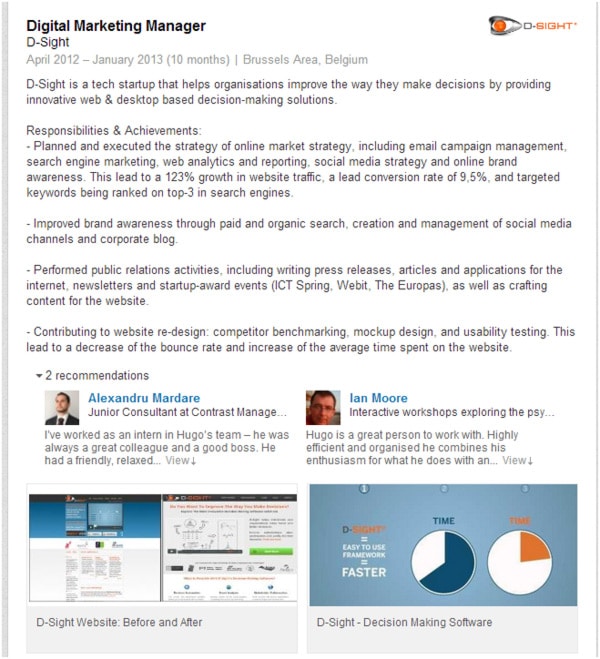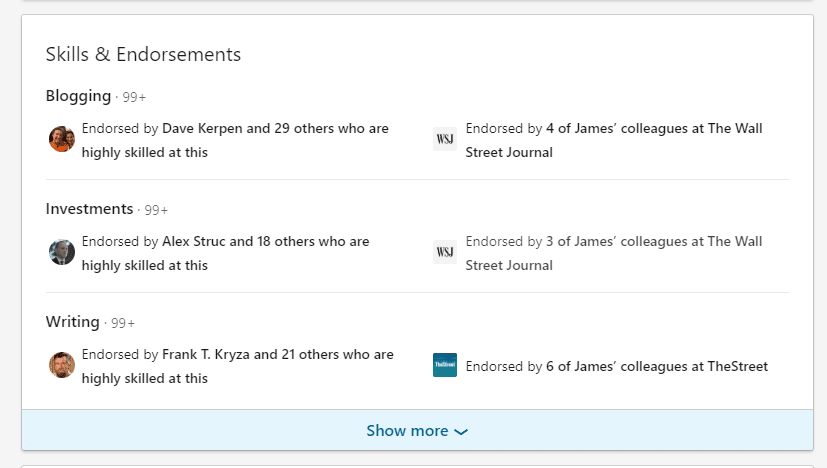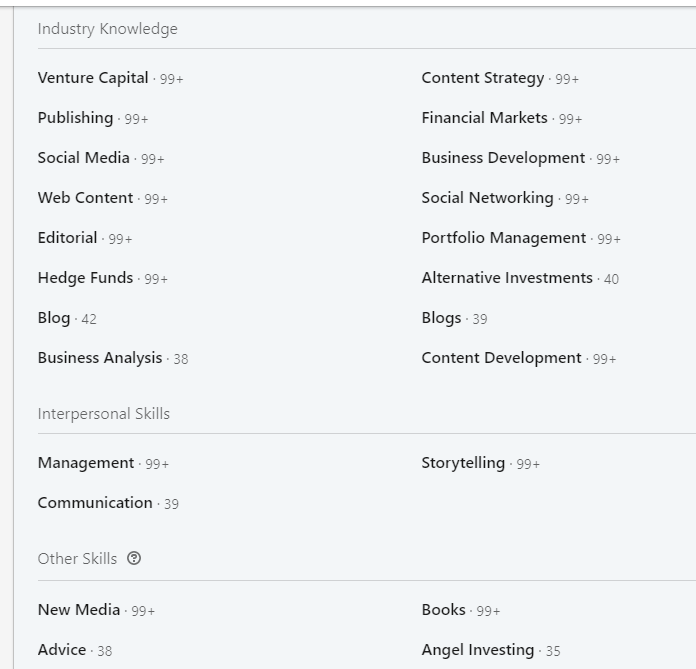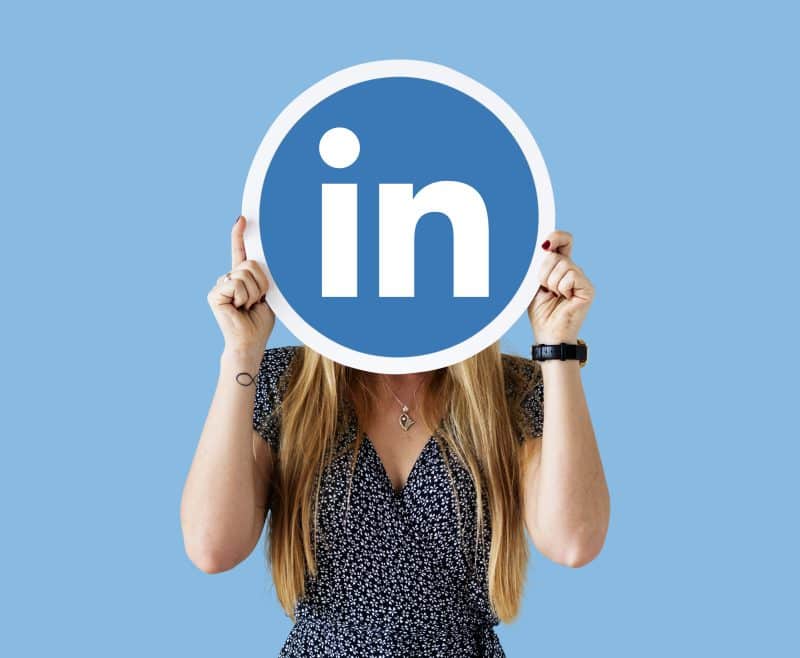Not only are they researching candidates, but recruiters are also searching for new employees online.
According to the recruitment platform Jobvite, 77% of recruiters look for new talent on LinkedIn, with Facebook coming in close behind at 63%.
What do these numbers mean to you, the job seeker?
It means you need to get your LinkedIn profile in order, and right quick.
A well-crafted LinkedIn profile allows you to provide something that no resume or cover letter can. It lets you showcase yourself in multiple dimensions, to paint a picture of yourself as a whole person, instead of just the typical resume’s collection of dates and buzzwords.
This LinkedIn Profile guide will give you the information you need to create the perfect LinkedIn profile to make an outstanding first impression with recruiters and potential employers – while also helping you build your professional brand and expand your professional network in general.
Setting Up Your LinkedIn Profile for Maximum Results
If you’re not active on LinkedIn (or if you just haven’t gotten around to optimizing, expanding, or updating your profile in a while…or ever), it can be difficult to know where to start in your efforts to turn your basic profile into an opportunity magnet.
This guide will walk you through the key elements of an effective LinkedIn profile and best practices for getting noticed. Future posts will cover more advanced techniques.
One note to keep in mind: Details are critical. It is important to pay attention to the little things, such as spelling and grammar, throughout your profile. I’ve seen great profiles undermined by typos and minor errors.
Part 1: Your Basic LinkedIn Profile
Note: To punch up any of these elements of your LinkedIn profile, simply select Edit Profile and the Edit icon for the appropriate section.
What’s in a Name?
When it comes to your name, it’s best to keep it plain and simple. More importantly, it makes it easier for potential employers to find your profile.
Resist the temptation to include things like Killer Video Game Programmer or Tax Shredding CPA. Stick to the basics – first and last name.
For SEO purposes, you can highlight your skills and experiences in your “About” section.
Headline Design for Success
Your headline is one of the most important portions of your LinkedIn profile. Not only is it an excellent place to include critical career-minded keywords, but it will show up frequently throughout key LinkedIn locations such as:
- Search Results
- Connection Invitations
- Employee Listings
- Company Pages
- Messages
This is the place where you can use some superlatives and creative wordsmithing in order to attract attention. You want to keep it professional, but this is an important opportunity to make yourself memorable. Don’t squander it.
At its heart and soul, LinkedIn is another search engine. Whatever you choose to make your headline say, make it something searchable that will help people who are looking for the services you provide or the particular skill set you to bring to the table find you.
Just take a look at the keyword-laden, yet memorable LinkedIn headline for John Paul Engel.

Helpful Hint: Have you won any professional awards? There’s no harm in the headline Award Winning Graphic Designer or something similar as long as you have won at least one verifiable award in your profession.
The Right Picture is Worth a Thousand Words
Your photograph is a visual representation of who you are to the world of LinkedIn. Don’t go with a grainy ten-year-old summer vacation photograph. Your best bet is to use a professional-looking headshot. Depending on your profession and your intended audience, you can also opt for something more approachable and casual (but still professional).
According to Business Insider, people remember faces better than they remember names – that’s why headshots are preferable.
A professional photo also helps to verify that you are who you say you are. It builds credibility and trust with the recruiter.
Many cell phones include high-quality cameras that can give you an excellent LinkedIn profile picture. Additionally, there are many photo editing software options available for free online that can help you edit your LinkedIn profile picture to be exactly the way you want it.
URL Customization
On the upper right of your profile, just under the toolbar, will be an option that says, “Edit public profile and URL.”
If you click on this, you will be taken to a page that will enable you to edit your URL.
Customizing your LinkedIn URL makes it easier for people to find you by searching for your name. Otherwise, they’re left sifting through the hundreds of LinkedIn visitors who have names similar to yours when looking for you.
Most users have some combination of name and several numbers as a default URL. You want to shorten that to your first and last name if possible. If your ideal custom url is already taken, look for a memorable combination of initials and last name, throw in your middle name, or otherwise get creative so that people will be able to find you easily.
Why is this step important?
Aside from making you easier to find by people who are looking for you, this also allows you to develop continuity between social media accounts such as Twitter, Facebook, Pinterest, and even your blog – assuming you have one. These are all places prospective employers are likely to visit trying to learn a little more about the person behind the profile.
Make Your Summary the Focal Point of Your Profile
Just like the summary on the resume, the summary on your LinkedIn profile really gives users like you an opportunity to shine. This is your space to differentiate yourself from all the other computer programmers, accountants, marketers, and other professionals in the job market today.
You want to highlight your strongest skills and most impressive accomplishments in 4 or so sentences.
Think of this as your elevator pitch; create a snap-shot of your professional “greatest hits” and put them together succinctly.
You really want to avoid generic language like, “experienced in Marketing.”
Instead, you could say: “Increased ROI of social media campaigns by 15%.”
Give hard, quantifiable evidence of your skills and abilities whenever possible.
LinkedIn also allows you to add videos, links, images, and documents to this section so employers can see some of your finest work at a glance. Utilize this capability!
Refresh and revise your summary section regularly. You always want your information to be accurate and up to date.
Helpful Hint: You can use your LinkedIn profile as a portfolio as well as a digital resume by taking full advantage of the ability to upload photos, videos, links, and documents. Photojournalists may want to include their favorite shots, bakers can feature photos of wedding cakes or cupcakes that have earned accolades from satisfied customers, etc.
Don’t fill this section with tired, boring details. Make it come alive with real-world evidence of your contribution to your industry. You can use any of the following tools to do that.
- Video
- Images
- Audio
- Presentations
- Slide Shows
- Documents
- And More
Your Experience, Skills, and Expertise are More Than the Sum of Their Parts
Resist the temptation to cut and paste your resume into the experience column of your LinkedIn profile. Try to use words in this section to paint a revealing portrait of the skills and talents you possess.
This section is much more than a description of previous jobs. Keep this section of your profile easy for readers to scan quickly, but also make an effort to showcase your accomplishments, talents, and accolades in a compelling manner.
LinkedIn also allows you to bring your descriptions to life with images, videos, recommendations, and other compelling extras.
LinkedIn Experience Section Example
Hugo Pereira is a Brussels-based marketing professional who successfully used LinkedIn to fast-track his last two job searches. See below for the job description of a previous role that helped him land his current gig. Note the focus on accomplishments (not just job duties) and the embedded recommendations and visual examples of his past work.

Remember: Your primary goal is to be found by employers and HR personnel interested in people with your unique experience and talent. Use the words they’ll be looking for when describing your industry experience.
Part 2: Your LinkedIn Connections
The next important aspect of your LinkedIn profile is connecting to the people you (don’t) know and the people you want to know.
LinkedIn Connections – How Does Your Network Grow?
Connections are a huge part of what makes LinkedIn such a force and invaluable tool for good to people searching for jobs.
Why are connections so critical on LinkedIn?
It’s not just the first-level connections that are critical. It’s the additional connections you can make because of those people who know you and (hopefully) love you.
Your primary connections serve as introductions to the people they know – to people and opportunities around the world and across industries.
Of course, there are some potential employers, such as John Paul Engel, quoted below, who look for those vital connections as a sign of credibility.
Sidebar: The Recruiter’s Perspective
John Paul Engel is the president of a recruiting firm that serves high-growth companies in cable, payments, and professional and financial services.
He kindly shared his thoughts on what gets his attention (positively and negatively) when he’s scouting for talent on LinkedIn.
Turn-ons:
- Keywords related to the job. (In particular, listing software names (e.g. Omniture, Tableau) makes it easier to find your profile for related positions)
- Measurable accomplishments. (Give me dollar estimates and/or other hard numbers!)
- Well-written copy
- Complete profiles (Fill out the details under education and job entries.)
- Key accomplishments that make you stand out
- Lots of connections – particularly if we share some
- Great recommendations from executives
Turn-offs:
- Goofy picture (You posing in your muscle shirt next to Donald Duck)
- Weird jobs or job descriptions (Chairman of the Chocolate Factory, CEO of the Smith Family)
- Key information missing
- Single-digit connection list
- Recommendations only from very junior-level connections
LinkedIn Groups
Believe it or not, groups are one of the most important things going on LinkedIn these days. Katherine Long of Illustria Designs says she often sifts through industry-related groups in search of potential talent.
It’s not enough to simply be listed as a group member, however. That won’t make you stand out. You need to be an active participant in groups in order to stand out as a leader in your industry. Active involvement in groups helps you make new primary connections, which, in turn, grows your exposure to people who are looking for employees with your skillset.
There’s the added benefit that some people in these groups may be looking for someone just like you as a coworker, employee, or collaborator on a project that will increase your exposure even more.
Striking Out on Your Own
While participating in groups is a great way to branch out and make new connections in your industry or related industries, starting your own group brings a deeper sense of gravitas to the situation.
Mashable highly recommends starting your own group as one of the most powerful tools you can use to solidify your brand in the business or as a strong job candidate in your industry. Don’t begin a group for your business or industry in general though. Find a specific area of your industry and establish yourself as the employee businesses want to have. Present yourself as an expert in that little niche.
The benefits of starting your own group are wide and varied and include all the following – and more.
- Establishes you as an industry leader.
- Displays leadership capabilities.
- Shows businesses you know your stuff.
- Gives you a slight edge over competitors for the same job who have lower-profile presences on LinkedIn.
- Generates a personal mailing list for you.
- Facilitates connections that would not otherwise have been possible.
- Makes you an attractive commodity for employers interested in your knowledge (or insuring their competitors do not gain access to it).
Once you’ve gotten the basics of groups, group participation, and group leadership down, it’s time to move on to something many LinkedIn users struggle with in building their LinkedIn presence–recommendations and endorsements.
Recommendations and Endorsements
Both recommendations and endorsements can strengthen your LinkedIn presence by offering third-party validation of your experience and strengths. This is another way in which a LinkedIn profile can offer much more than a resume can.
1. LinkedIn Endorsements
LinkedIn allows connected users to endorse each other for certain skills. Endorsements are different from recommendations, and generally not quite as impressive because users are simply checking a box and aren’t actually providing any details.
It’s easy to endorse somebody, so it’s not quite the same as someone taking the time to sing your praises in detail (see Recommendations below). Endorsements are, however, testaments to your abilities in certain fields and welcome additions to your LinkedIn profile, particularly for job seekers.
Endorsements show up in your profile like this.

Notice that you can only display your top 3 endorsements at any given time.
You can add more Skills to be endorsed by clicking “Add a New Skill” to the right of your skills list.
In the window that opens, you can not only add more skills but also select which of your skills you want to be displayed in your top 3.
The other skills you’ve listed beyond your top 3 are still viewable. Simply click, “Show More” and your entire list will appear.

Keep in mind that only your top 3 skills will appear when setting up your profile. You want to make sure that your best, most relevant, and highly endorsed skills are viewable first.
2. LinkedIn Recommendations
A recommendation, on the other hand, is a written statement of recommendation from one of your LinkedIn connections. A positive recommendation will add significantly more credibility than an endorsement because someone took the time to provide details about your strengths and accomplishments — and sign their name.
Recommendations from former managers and higher-level colleagues/clients tend to carry the most weight with hiring managers and recruiters. However, any positive recommendation can add significant depth and reliability to your profile.

You ask for a recommendation on LinkedIn in the same way you ask for a recommendation in real life — personally and respectfully. Start with people who know you and love you in real life right now and then expand out to reconnect with fans from your past. Write a recommendation for someone you respect and that person is likely to want to return the favor (assuming he or she knows you well enough and has a positive perception of you).
Our next post in this series will provide more detailed tips on how to ask for and receive fantastic LinkedIn recommendations.
Avoid a Few Mistakes by Remembering These Helpful Points
Mistakes are made daily when creating LinkedIn profiles. These three big mistakes can sabotage your efforts to make the most of LinkedIn as a job search tool.
1. Failing to Adjust Your Privacy Settings
In a job search situation, you want the world to be able to find you. People with open positions are actively looking for candidates on LinkedIn, but you have to be visible to get any action.
Don’t make the mistake of turning on privacy settings so that your connections aren’t able to find and view your profile. Make it available far and wide to get more mileage from your job search efforts.
You can edit your privacy settings in the same area as you customize your URL–to the right under the toolbar.
It will look like this:

2. Inconsistent or Infrequent Updates
If you’re actively searching for a new job, you need to be actively updating your LinkedIn profile.
People are busy and it helps to jog their memory about you and your brilliance. Share an article, add to your portfolio, spruce up your summary.
While you do not have to provide hourly updates, you do need to share status updates, and you need to share often.
Tatiana Mulry is a mobile marketing consultant and speaker who often finds new clients and opportunities via LinkedIn. She attributes this success primarily to staying active. “I make frequent posts of content related to my specialty into the newsfeed and people say, ‘I always think of you when I see you posting articles.’”
3. Neglecting to Personalize Connection Requests
Don’t go for the LinkedIn default message when you’re attempting to make connections. While I’m sure you are a memorable person, sometimes people need a little prompting to remember how they know you.
This is particularly true if you’ve only met the person briefly or if it’s been a while since you were in touch.
Take a few minutes to draft a personalized message with your request. Briefly remind your connection of how you know each other and express your interest in staying in touch.
In Summary
Your LinkedIn strategy can make or break your job search effort. If you apply the tips in this LinkedIn profile guide, you’ll see for yourself not only the kind of wow factor they bring to your profile, but how your LinkedIn profile can help recruiters and employers more easily find you —– and, more importantly, be impressed.
Next Up: This guide covered some of the core areas of the LinkedIn profile. In future posts, we’ll cover some more advanced techniques for finding a job on LinkedIn — including sprucing up other profile areas (like Honors & Awards, Volunteer Experiences & Causes, Following, etc.) and expanding your network and your reach to identify more opportunities.
Additional Resources: Read Big Interview’s 15 Power Tips for Using Your Social Network to Find a Job.
HUMOR: Conan O’Brien discusses the keys to becoming a LinkedIn Influencer.
Main Photo: A Name Like Shields
